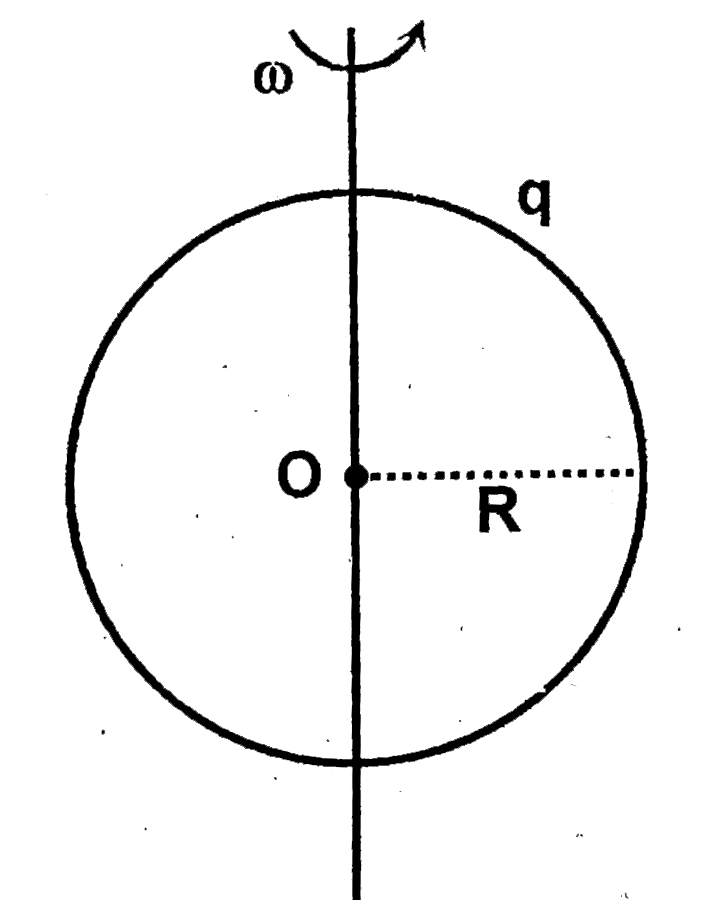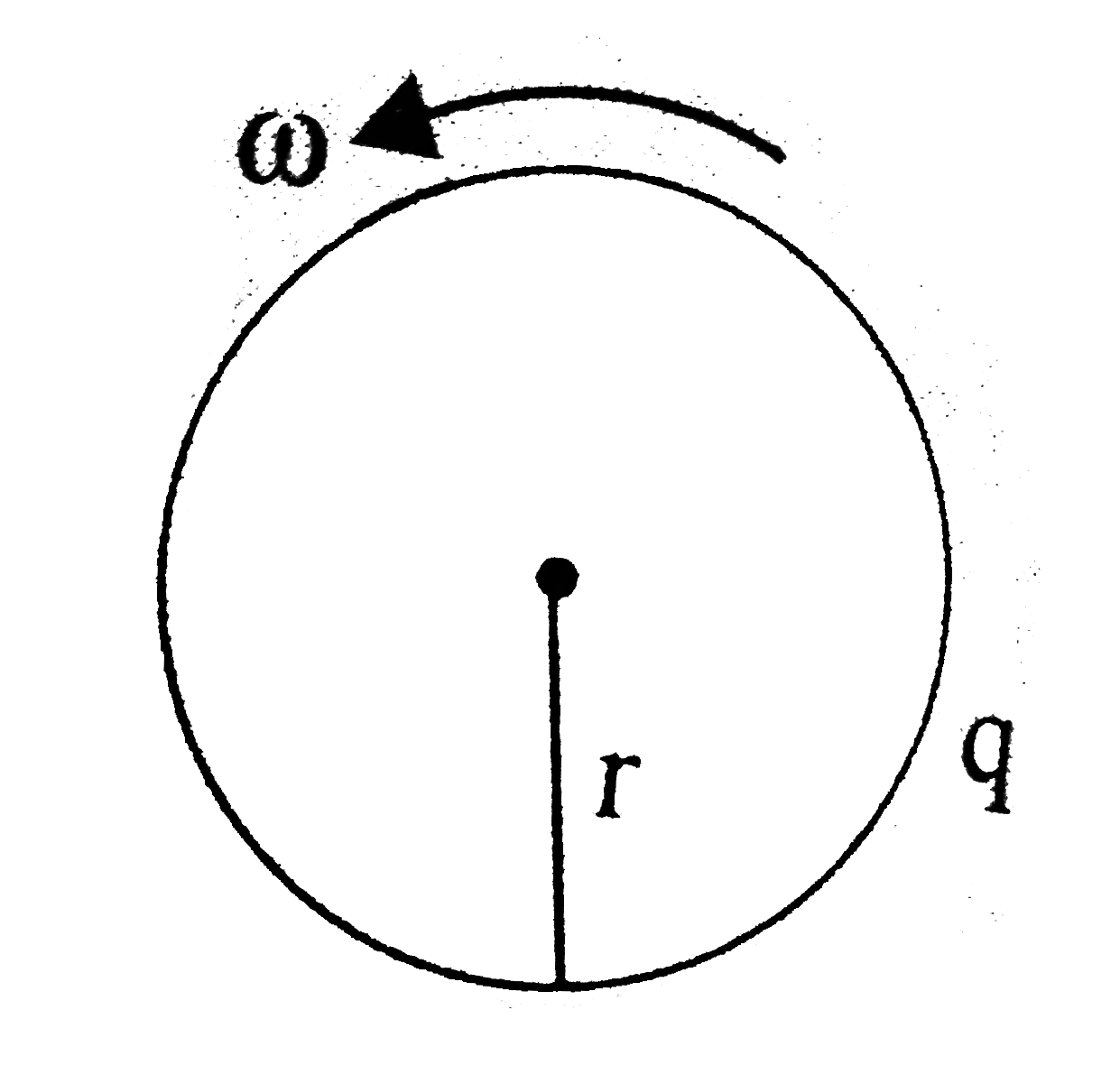A non-conducting sphere of radius R=50mm charged uniformly with surface density σ=10.0μC/m2 rotates with an angular velocity ω=70 rad/s about the asxis passign thorugh its centre. Find the magnetic induction at the centre of the sphere.
As only the outer surface of the sphere is charged, consider the element as a ring, as shown in figure.
The equivalent current due to the ring element,
di=ω2π(2πrsinθrdθ)σ ....(1)
and magentic indruction due to this loop element at the centre of the sphere, O,
dB=μ04πdi2πrsinθrsinθr3=μ04πdisin2θr
Hence, the total magentic induction due to the sphere at the centre, O,
B=∫dB=∫π/20μ04πω2π2πr2sinθdθsin2θσr
Hence, B=∫π/20μ0σωr4πsin3θdθ=23μ0σωr=29pT

Topper's Solved these Questions
- BOOK - IE IRODOV, LA SENA & SS KROTOVCHAPTER - ELECTRODYNAMICSEXERCISE - Electromagnetic Induction84videos
ELECTRODYNAMICS
- BOOK - IE IRODOV, LA SENA & SS KROTOVCHAPTER - ELECTRODYNAMICSEXERCISE - Motion Of Charged Particle In Magnetic Field36videos
ELECTRODYNAMICS
- BOOK - IE IRODOV, LA SENA & SS KROTOVCHAPTER - ELECTRODYNAMICSEXERCISE - Electric Current72videos
ELECTRODYNAMICS
- BOOK - IE IRODOV, LA SENA & SS KROTOVCHAPTER - ELECTRICITY AND MAGNETISMEXERCISE - All Questions6videos
ELECTRICITY AND MAGNETISM
- BOOK - IE IRODOV, LA SENA & SS KROTOVCHAPTER - ELECTROMAGNETISMEXERCISE - All Questions24videos
ELECTROMAGNETISM
Similar Questions
A non-conducting thin disc of radius R charged uniformly over one side with surface density σ, rotates about its axis with an angular velocity ω. Find (a) the magnetic field induction at the centre of the disc (b) the magnetic moment of the disc.
View SolutionA non-conducting thin disc of radius R and mass m having charge uniformly over one side with surface density σ rotates about its axis with an angular velocity ω. Find :
(a) the magnetic induction at the centre of the disc,
(b) the magnetic moment of the disc.
( c) the ratio of magnetic moment and angular momentum of disc.View Solution
Knowledge Check
- Question 1 - Select One
A hollow non conducting sphere of radius R has a positive charge q uniformly distributed on its surface. The sphere starts rotating with a constant angular velocity 'ω' about an axis passing through center of sphere, as shown in the figure. Then the net magnetic field at center of the sphere is
 Aμ0qω2πRBμ0qω3πRCμ0qω6πRDμ0qω12πR
Aμ0qω2πRBμ0qω3πRCμ0qω6πRDμ0qω12πR - Question 2 - Select One
A copper ball of mass m=1kg with a radius of r=10cm rotates with angular velocity ω=2rad/s about an axis passing through its centre. The work should be performed to increase the angular velocity of rotation of the ball two fold is.
A1.2×10−2JB2.4×10−2JC3.6×10−2JD4.8×10−2J - Question 3 - Select One
A non conducting sphere of radius R is charged uniformly. At what distance from its surface is the electrostatic potential is half the potential at its centre ?
ARBR/2CR/3D2R
A non-conducting thin disc of radius R charged uniformly over one side with surface density s rotates about its axis with an angular velocity ω. Find
(a) the magnetic induction at the centre of the disc,
(b) the magnetic moment of the disc.View SolutionA non-conducting thin disc of radius R charged uniformly over one side with surface density σ, rotates about its axis with an angular velocity ω. Find (a) the magnetic field induction at the centre of the disc (b) the magnetic moment of the disc.
View SolutionA small body of mass m=0.30kg starts sliding down from the top of a smooth sphere of radius R=1.00m. The sphere rotates with a constant angular velocity ω=6.0rad/s about a vertical axis passing through its centre. Find the centrifugal force of inertia and the Coriolis force at the moment when the body breaks off the surface of the sphere in the reference frame fixed to the sphere.
View SolutionA conducting ring of radius r having charge q is rotating with angular velocity ω about its axes. Find the magnetic field at the centre of the ring.
 View Solution
View SolutionA shpere of radius r carries a surface charge a density σ=ar, where a is a constant, vector and r is radius vector of a point of the sphere ralative to its centre. Find the electric field strength vector at the centre relative at the centrre of the sphere.
View Solution

